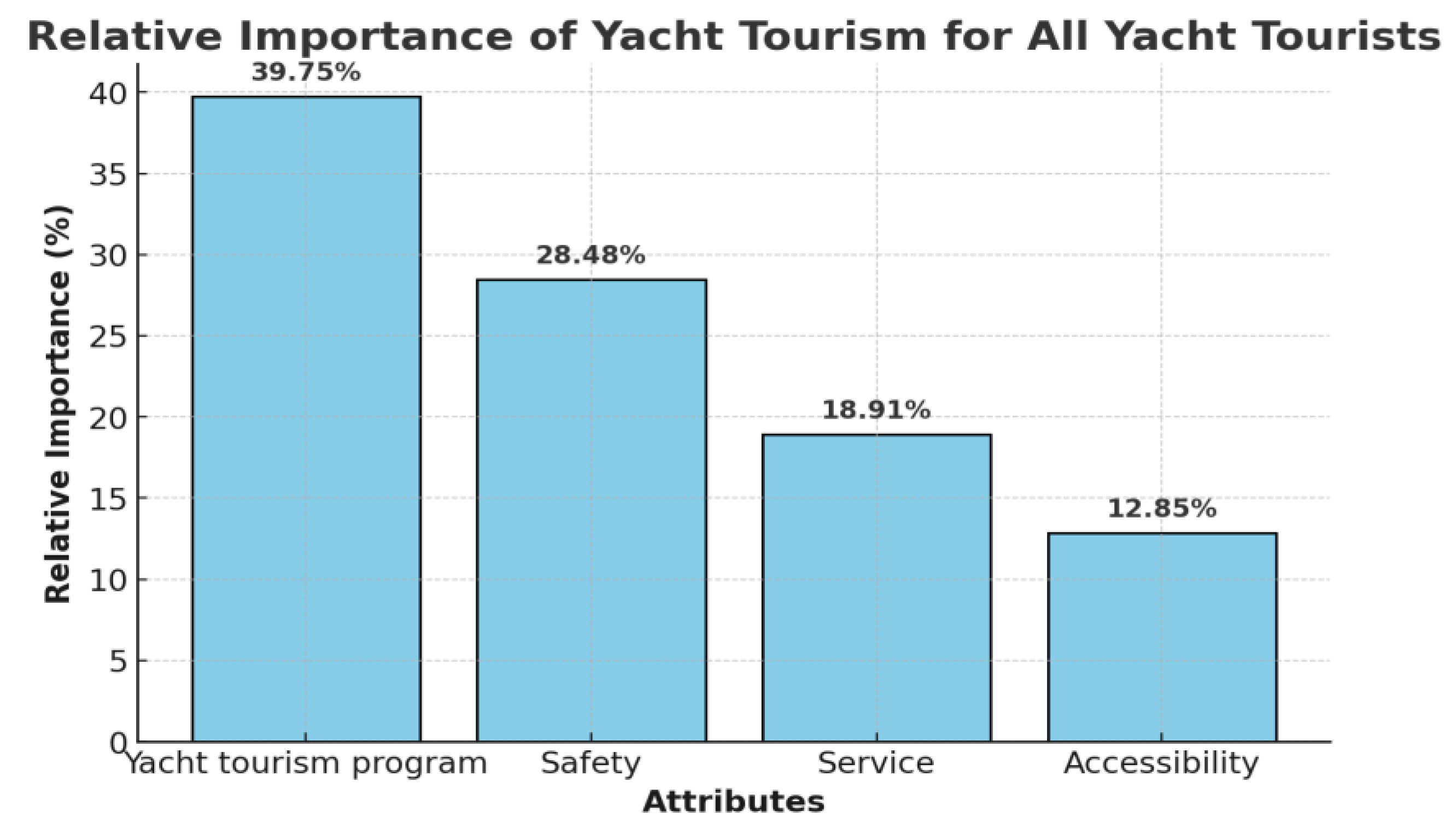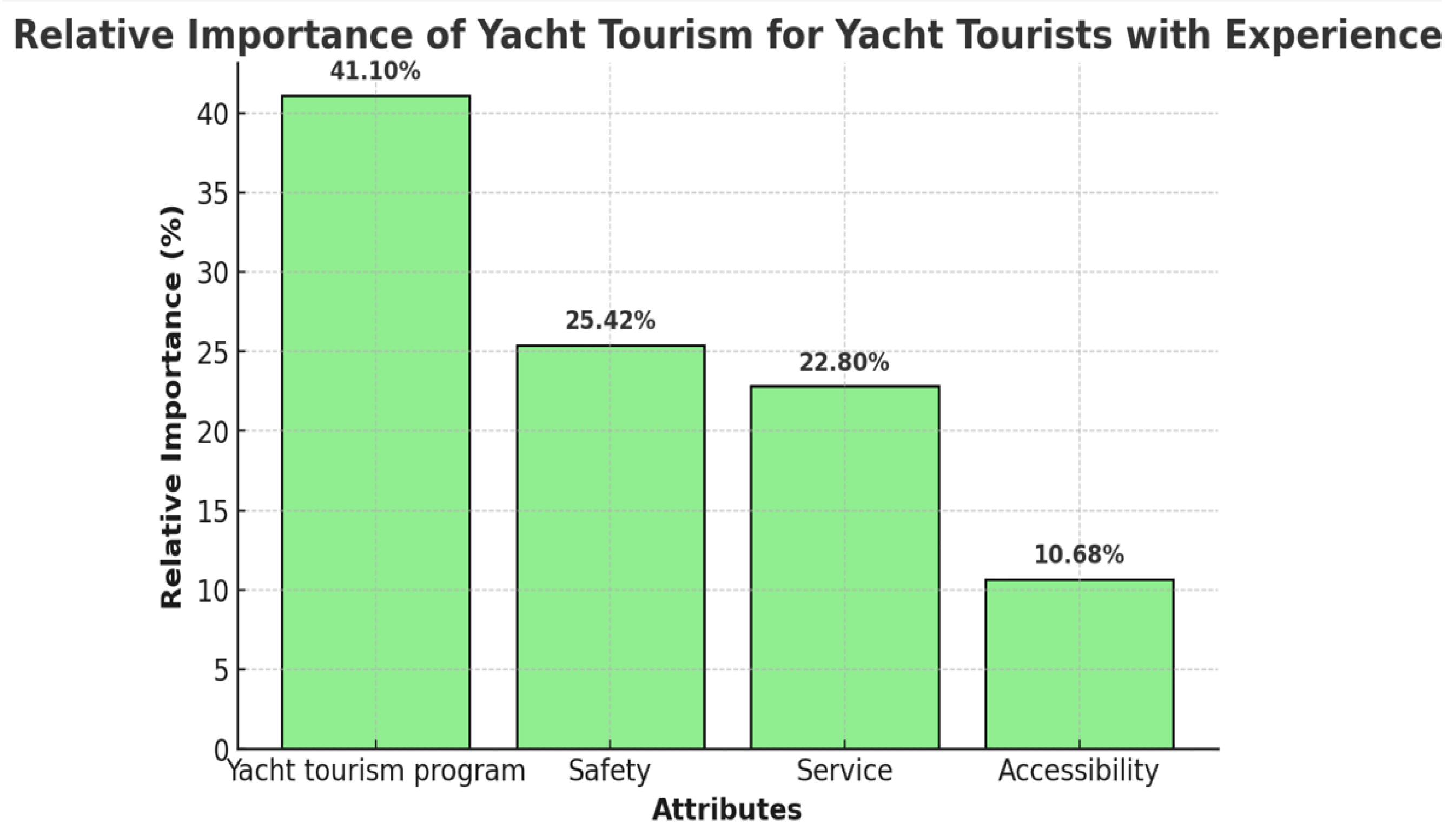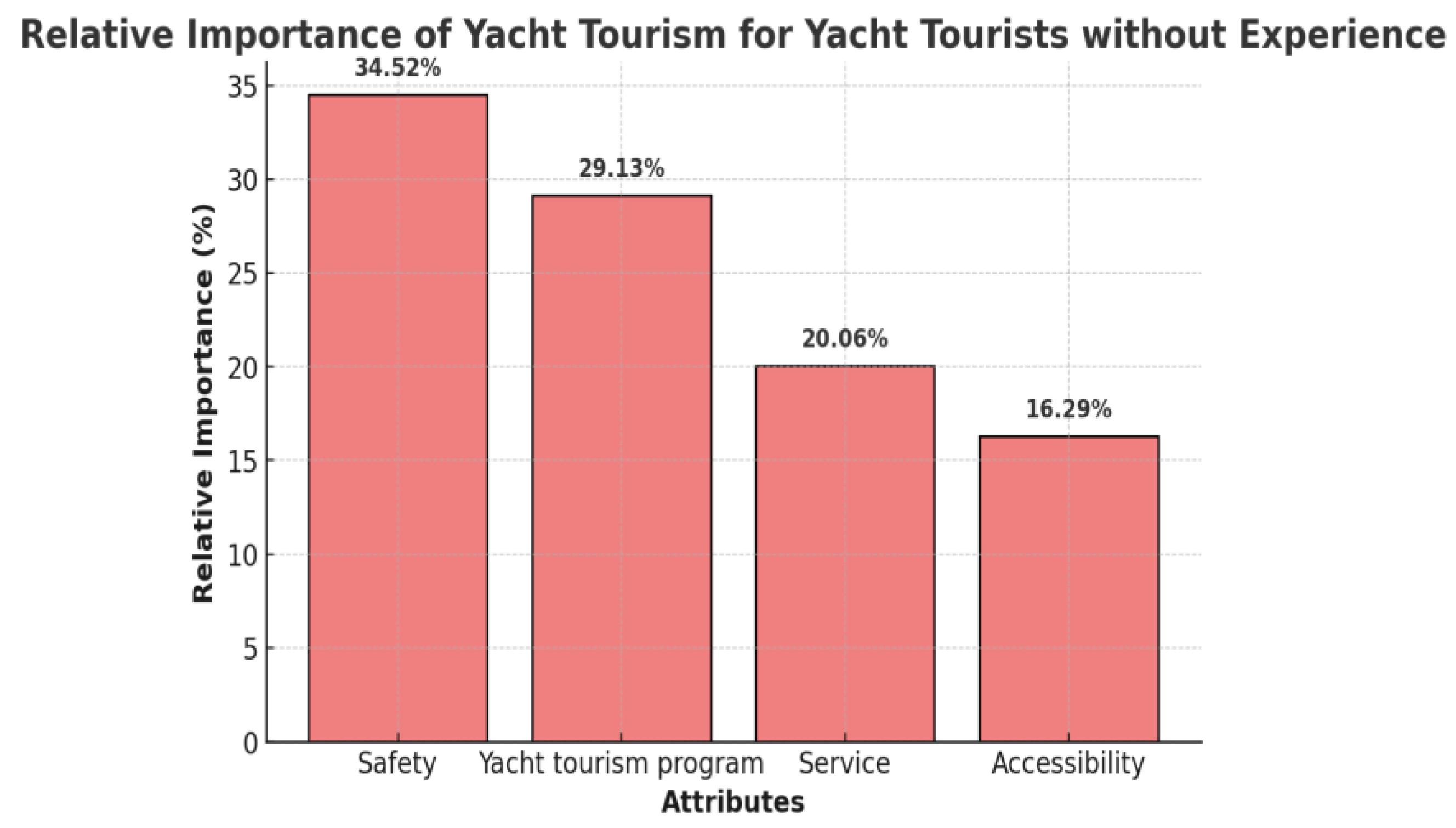Key Attributes Driving Yacht Tourism: Exploring Tourist Preferences Through Conjoint Analysis
Abstract
1. Introduction
2. Literature Review
2.1. Yacht Tourism
2.2. Conjoint Analysis
3. Materials and Methods
3.1. Data Collection
3.2. Measurement
3.3. Data Analysis
3.4. Instrument
4. Results
4.1. Aggregate Conjoint Analysis
4.2. Conjoint Analysis by Prior Yacht Tourism Experience
4.3. Optimal Combination of Yacht Tourism Attributes
5. Discussion
6. Conclusions
Author Contributions
Funding
Institutional Review Board Statement
Informed Consent Statement
Data Availability Statement
Conflicts of Interest
References
- Zhao, W. A golden decade for ocean science (2021–2030): From knowledge to solutions and actions. Natl. Sci. Rev. 2021, 8, nwab021. [Google Scholar] [CrossRef] [PubMed]
- Battistella, C.; Cagnina, M.R.; Cicero, L.; Preghenella, N. Sustainable business models of SMEs: Challenges in yacht tourism sector. Sustainability 2018, 10, 3437. [Google Scholar] [CrossRef]
- Sun, J.S.; Yan, H.D. Competitive advantages and the transformation of Taiwan’s yacht industry. Int. J. Econ. Bus. Res. 2018, 16, 421–441. [Google Scholar] [CrossRef]
- Sevinç, F.; Güzel, T. Sustainable yacht tourism practices. Manag. Mark. J. 2017, 15, 61–76. [Google Scholar]
- Yoon, J.; Lee, S. The structural relationship among perceived value, attitude, and behavioral intention of marina yacht experience participants: Focused on Geoje Marinabay yacht users. Int. J. Tour. Hosp. Res. 2019, 33, 47–60. [Google Scholar]
- Wang, L.; Zhang, H. The impact of marine tourism resources development on sustainable development of marine economy. J. Coast. Res. 2019, 94, 589–592. [Google Scholar] [CrossRef]
- Poddubnaya, T.; Zadneprovskaya, E. Yacht tourism on the Azov-Black Sea coast of Russia as a factor of tourist attractiveness of the region. Regionology 2022, 30, 324–341. [Google Scholar] [CrossRef]
- Ajagunna, I.; Casanova, S. An analysis of the post-COVID-19 cruise industry: Could this be a new possibility for the luxury yacht sector in the Caribbean? Worldw. Hosp. Tour. Themes 2022, 14, 115–123. [Google Scholar] [CrossRef]
- Zentner, H.; Gračan, D.; Sotošek, M.B. Digital business models in the hospitality sector: Comparing hotel bookings with yacht charter bookings. Sustainability 2022, 14, 12755. [Google Scholar] [CrossRef]
- Lee, J. Development plan for marine leisure tourism in Korea: Focusing on blue tourism. J. Mar. Tour. Res. 2021, 14, 27–46. [Google Scholar] [CrossRef]
- Pai, S.; Ananthakumar, U. Understanding tourist preferences for travel packages: A conjoint analysis approach. Asia Pac. J. Tour. Res. 2017, 22, 1238–1249. [Google Scholar] [CrossRef]
- Coscia, C.; Pasquino, F. Demand analysis models to support cultural tourism strategy: Application of conjoint analysis in North Sardinia (Italy). Land 2023, 12, 2150. [Google Scholar] [CrossRef]
- The World Bank. Available online: https://documents1.worldbank.org/curated/en/099107104222433189/pdf/IDU1bc68a29b1f0d614a7219bdd12579e39c55ef.pdf (accessed on 20 March 2025).
- Muela, G.M.; Arnaiz, F.C. Yachting Tourism. In Encyclopedia of Tourism; Springer: Cham, Switzerland, 2025; pp. 1141–1145. [Google Scholar]
- Yao, Y.; Li, Z.; Zhou, X.; Parmak, M. Yachting Tourism Consumption Potential and Its Influencing Factors: Considering 12 Coastal Cities in China as Examples. Sustainability 2023, 15, 12490. [Google Scholar] [CrossRef]
- Alcover, A.; Alemany, M.; Jacob, M.; Payeras, M.; García, A.; Martínez-Ribes, L. The economic impact of yacht charter tourism on the Balearic economy. Tour. Econ. 2011, 17, 625–638. [Google Scholar] [CrossRef]
- Payeras, M.; Jacob, M.; Garcia, A.; Alemany, M.; Alcover, A.; Martínez-Ribes, L. The yachting charter tourism SWOT: A basic analysis to design marketing strategies. Tourismos 2011, 6, 111–134. [Google Scholar] [CrossRef]
- Diakomichalis, N.M.; Kalantonis, P.; Diakomihalis, M. Yachting Tourist Expenditure and Its Effect on the Local Economy: The case of Lefkada. In Proceedings of the International Conference on Business & Economics, Patra, Greece, 6 March 2024. [Google Scholar]
- Chomác-Pierzecka, E.; Stasiak, J. Domestic tourism preferences of Polish tourist services’ market in light of contemporary socio-economic challenges. In Strategic Innovative Marketing and Tourism; Springer: Cham, Switzerland, 2024; pp. 479–487. [Google Scholar] [CrossRef]
- Kim, J.; Choi, E.-Y. Analysis of demand and expenditure determinants in yacht tourism. J. Sport All 2016, 66, 127–138. [Google Scholar] [CrossRef]
- Cavusoglu, M.; Dogan, S.; Yozcu, O.-K.; Hsu, M.-J.; Cobanoglu, C. A conjoint analysis of attributes influencing attendance of academic conferences. Int. J. Contemp. Hosp. Manag. 2023, 35, 3263–3284. [Google Scholar] [CrossRef]
- Dean, D.-H. Evaluating potential brand associations through conjoint analysis and market simulation. J. Prod. Brand Manag. 2004, 13, 506–513. [Google Scholar] [CrossRef]
- Louviere, J.; Flynn, T.; Carson, R. Discrete choice experiments are not conjoint analysis. J. Choice Model. 2010, 3, 57–72. [Google Scholar] [CrossRef]
- Mühlbacher, A.C.; Kaczynski, A.; Zweifel, P.; Johnson, F.R. Experimental measurement of preferences in health and healthcare using Best-Worst Scaling: An Overview. Health Econ. Rev. 2016, 6, 5. [Google Scholar] [CrossRef]
- Schuster, A.L.R.; Crossnohere, N.L.; Campoamor, N.B.; Hollin, I.L.; Bridges, J.F.P. The rise of best-worst scaling for prioritization: A transdisciplinary literature review. J. Choice Model. 2024, 50, 100466. [Google Scholar] [CrossRef]
- Ulengin, B.; Ulengin, F.; Guvenc, U. A multidimensional approach to urban quality of life: The case of Istanbul. Eur. J. Oper. Res. 2001, 130, 361–374. [Google Scholar] [CrossRef]
- Sharma, S.; Dwivedi, Y.; Misra, S.; Rana, N. Conjoint analysis of blockchain adoption challenges in government. J. Comput. Inf. Syst. 2023, 64, 173–186. [Google Scholar] [CrossRef]
- Jang, W.; Baek, S. The relative importance of servicescape in fitness center for facility improvement. Heliyon 2024, 19, e29562. [Google Scholar] [CrossRef] [PubMed]
- Jang, W.; Hwang, J. Exploration of relative importance of professional soccer stadium’s facility environment focused on conjoint analysis. Korean J. Sport Manag. 2020, 25, 94–108. [Google Scholar] [CrossRef]
- Marina Information System. Available online: https://infomarina.go.kr/ (accessed on 20 March 2025).
- Park, S.; Jeong, C. Effect of Busan yacht experience tourism on the stress recovery and behavioral intention of tourists. J. Korea Port Econ. Assoc. 2023, 39, 111–128. [Google Scholar] [CrossRef]
- Han, J. A case study for vitalization of marina operation. J. Humanit. Soc. Sci. 2023, 14, 5799–5810. [Google Scholar] [CrossRef]
- Roh, J.; Kim, T. The research on the influence of interaction effect of selection attribute of tourist destination and tour frequency on satisfaction of yacht tour. J. Sport All 2016, 64, 407–421. [Google Scholar] [CrossRef]
- Kim, Y.; Kim, G.; Kim, H.; Jung, Y. Effects of the marina facility’s attractive attribute, service quality and customer satisfaction on the loyalty. J. Korean Data Anal. Soc. 2015, 17, 321–332. [Google Scholar]
- Jonvirat, R. Understanding Yacht Tourists’ Destination Loyalty in Phuket, Thailand: A Causal Relationship Model of the Influence of Perceived Marina Attributes, Tourist Perceived Value, with the Mediating Role of Destination Image, and Tourist Satisfaction. Ph.D. Thesis, The Graduate School of Tourism Management National Institute of Development Administration, Bangkapi, Thailand, 2023. [Google Scholar]
- Yao, Y.; Zheng, R.; Parmak, M. Using an evaluation index system to examine the developmental potential of yachting tourism. J. Coast. Res. 2022, 38, 1195–1206. [Google Scholar] [CrossRef]
- Shen, Y.; Kokkranikal, J.; Christensen, C.P.; Morrison, A.M. Perceived importance of and satisfaction with marina attributes in sailing tourism experiences: A kano model approach. J. Outdoor Recreat. Tour. 2021, 35, 100402. [Google Scholar] [CrossRef]
- Mikuli’c, J.; Kreši’c, D.; Koži’c, I. Critical factors of the maritime yachting tourism experience: An impact-asymmetry analysis of principal components. J. Travel Tour. Mark. 2015, 32 (Suppl. S1), S30–S41. [Google Scholar] [CrossRef]
- Jang, W.; Choi, K. Factors influencing choice when enrolling at a fitness center. Soc. Behav. Pers. 2018, 46, 1043–1056. [Google Scholar] [CrossRef]
- Jang, W.; Lee, K.; Won, D. The market segmentation through purchasing decision factors of outdoor sports wear using conjoint analysis. Korean J. Sport Manag. 2015, 20, 117–130. [Google Scholar]
- Steiner, M.; Meißner, M. A user’s guide to the galaxy of conjoint analysis and compositional preference measurement. Mark. ZFP J. Res. Manag. 2018, 40, 3–25. [Google Scholar] [CrossRef]
- Sung, B.; Park, K.; Kim, Y.; Lee, J.; Jin, E. What drives researcher preferences for chemical compounds? Evidence from conjoint analysis. PLoS ONE 2023, 18, e0294576. [Google Scholar] [CrossRef]
- Cho, W. Analyses of consumer preferences and perceptions regarding activation of yacht tourism industry. J. Navig. Port Res. 2012, 36, 401–407. [Google Scholar] [CrossRef]
- Hyun, W. Promoting Yacht Industry as One of Marine New Industries. In Proceedings of the Korean Society for Marine Environment & Energy of the Conference, Jeju, Republic of Korea, 2013. [Google Scholar]
- Kim, C.; Jung, Y.; Jeong, W. The structural relationship between experience factor, experience satisfaction and re-participation intention of KIMAWEEK yacht experience participants. J. Korea Contents Assoc. 2018, 18, 409–419. [Google Scholar] [CrossRef]
- Choi, E.-Y.; Cho, W. Personal watercraft incident court decisions: The plaintiff’s odds? Sustainability 2021, 13, 5096. [Google Scholar] [CrossRef]
- Lee, K. The exploration of the maritime city-customized marine sport model connected with education: Focused on Busan. Korean Soc. Sports 2012, 25, 1–17. [Google Scholar] [CrossRef]
- Lee, Y. Policy alternatives for yachting development in Korea. Korean Soc. Sports Policy 2011, 9, 75–90. [Google Scholar]
- Jang, S.; Lee, K. The characteristics of the sub-culture of cruiser yacht club member: Focused on the characteristics and identity of members. Korean J. Phys. Educ. 2010, 49, 35–50. [Google Scholar]
- Cho, W.; Choi, E.-Y. A study on impacts of COVID-19 on marine leisure tourism and government’s support policies. J. Sport All 2021, 84, 157–167. [Google Scholar] [CrossRef]
- Choi, E.-Y.; Cho, W. Effects of marine leisure tourism satisfaction factors on city marketing and residential intention. J. Sport All 2024, 98, 123–131. [Google Scholar] [CrossRef]



| Attributes | Level |
|---|---|
| Yacht tourism program |
|
| Safety |
|
| Service |
|
| Accessibility |
|
| Profiles | Yacht Tourism Program | Safety | Service | Accessibility |
|---|---|---|---|---|
| 1 | Yacht training programs | Yacht docking safety | Professional tour guides | A distance of over 1 h by transport |
| 2 | Yacht sailing Programs | Yacht docking safety | Professional tour guides | A distance of within 1 h by transport |
| 3 | Yacht sailing programs | Yacht docking safety | Availability of yacht marina facilities | A distance of over 1 h by transport |
| 4 | Yacht training programs | Safety training and equipment provision | Professional tour guides | A distance of within 1 h by transport |
| 5 | Yacht training programs | Safety training and equipment provision | Availability of yacht marina facilities | A distance of over 1 h by transport |
| 6 | Marine leisure sports experience programs | Yacht docking safety | Professional tour guides | A distance of within 1 h by transport |
| 7 | Yacht sailing programs | Safety training and equipment provision | Operation of yacht tourism information platforms | A distance of within 1 h by transport |
| 8 | Marine leisure sports experience programs | Yacht docking safety | Operation of yacht tourism information platforms | A distance of within 1 h by transport |
| 9 | Marine leisure sports experience programs | Yacht docking safety | Operation of yacht tourism information platforms | A distance of over 1 h by transport |
| 10 | Yacht sailing programs | Yacht docking safety | Operation of yacht tourism information platforms | A distance of over 1 h by transport |
| 11 | Yacht training programs | Safety training and equipment provision | Availability of yacht marina facilities | A distance of over 1 h by transport |
| 12 | Yacht sailing programs | Safety training and equipment provision | Availability of yacht marina facilities | A distance of within 1 h by transport |
| Attributes | Level | PWU | RI (%) | Rating |
|---|---|---|---|---|
| Yacht tourism program |
| −0.677 0.213 0.464 | 39.754 | 1 |
| Safety |
| −0.357 0.357 | 28.483 | 2 |
| Service |
| 0.190 −0.496 0.306 | 18.915 | 3 |
| Accessibility |
| 0.265 −0.265 | 12.848 | 4 |
| Pearson’s r = 0.857 (p < 0.001) | ||||
| Attributes | Level | PWU | RI (%) | Rating |
|---|---|---|---|---|
| Yacht tourism program |
| −0.697 0.277 0.420 | 41.104 | 1 |
| Safety |
| −0.398 0.398 | 25.420 | 2 |
| Service |
| 0.125 −0.489 0.364 | 22.801 | 3 |
| Accessibility |
| 0.401 −0.401 | 10.675 | 4 |
| Pearson’s r = 0.841 (p < 0.001) | ||||
| Attributes | Level | PWU | RI (%) | Rating |
|---|---|---|---|---|
| Yacht tourism program |
| −0.635 0.288 0.347 | 29.132 | 2 |
| Safety |
| −0.460 0.460 | 34.515 | 1 |
| Service |
| 0.222 −0.633 0.411 | 20.062 | 3 |
| Accessibility |
| 0.301 −0.301 | 16.291 | 4 |
| Pearson’s r = 0.825 (p < 0.001) | ||||
| Attributes | Level | PWU | RI (%) | PWU × RI |
|---|---|---|---|---|
| Yacht tourism program |
| −0.677 0.213 0.464 | 39.754 | −0.269 0.085 0.184 |
| Safety |
| −0.357 0.357 | 28.483 | −0.102 0.102 |
| Service |
| 0.190 −0.496 0.306 | 18.915 | 0.036 −0.094 0.058 |
| Accessibility |
| 0.265 −0.265 | 12.848 | 0.034 −0.034 |
| The optimal combination: Yacht sailing programs (0.184) + Safety training and equipment provision (0.102) + Operation of yacht tourism information platforms (0.058) + A distance of within 1 h by transport (0.034) = 0.378 | ||||
| Attributes | Level | PWU | RI (%) | PWU × RI |
|---|---|---|---|---|
| Yacht tourism program |
| −0.697 0.277 0.420 | 41.104 | −0.286 0.114 0.172 |
| Safety |
| −0.398 0.398 | 25.420 | −0.101 0.101 |
| Service |
| 0.125 −0.489 0.364 | 22.801 | 0.029 −0.112 0.083 |
| Accessibility |
| 0.401 −0.401 | 10.675 | 0.043 −0.043 |
| The optimal combination: Yacht sailing programs (0.172) + Safety training and equipment provision (0.101) + Operation of yacht tourism information platforms (0.083) + A distance of within 1 h by transport (0.043) = 0.399 | ||||
| Attributes | Level | PWU | RI (%) | PWU × RI |
|---|---|---|---|---|
| Yacht tourism program |
| −0.635 0.288 0.347 | 29.132 | −0.185 0.084 0.101 |
| Safety |
| −0.460 0.460 | 34.515 | −0.159 0.159 |
| Service |
| 0.222 −0.633 0.411 | 20.062 | 0.044 −0.127 0.082 |
| Accessibility |
| 0.301 −0.301 | 16.291 | 0.049 −0.049 |
| The optimal combination: Safety training and equipment provision (0.159) + Yacht sailing programs (0.101) + Operation of yacht tourism information platforms (0.082) + A distance of within 1 h by transport (0.049) = 0.391 | ||||
Disclaimer/Publisher’s Note: The statements, opinions and data contained in all publications are solely those of the individual author(s) and contributor(s) and not of MDPI and/or the editor(s). MDPI and/or the editor(s) disclaim responsibility for any injury to people or property resulting from any ideas, methods, instructions or products referred to in the content. |
© 2025 by the authors. Licensee MDPI, Basel, Switzerland. This article is an open access article distributed under the terms and conditions of the Creative Commons Attribution (CC BY) license (https://creativecommons.org/licenses/by/4.0/).
Share and Cite
Choi, E.-Y.; Jang, W.-Y.; Park, T.-H. Key Attributes Driving Yacht Tourism: Exploring Tourist Preferences Through Conjoint Analysis. Sustainability 2025, 17, 3336. https://doi.org/10.3390/su17083336
Choi E-Y, Jang W-Y, Park T-H. Key Attributes Driving Yacht Tourism: Exploring Tourist Preferences Through Conjoint Analysis. Sustainability. 2025; 17(8):3336. https://doi.org/10.3390/su17083336
Chicago/Turabian StyleChoi, Eui-Yul, Won-Yong Jang, and Tae-Hyun Park. 2025. "Key Attributes Driving Yacht Tourism: Exploring Tourist Preferences Through Conjoint Analysis" Sustainability 17, no. 8: 3336. https://doi.org/10.3390/su17083336
APA StyleChoi, E.-Y., Jang, W.-Y., & Park, T.-H. (2025). Key Attributes Driving Yacht Tourism: Exploring Tourist Preferences Through Conjoint Analysis. Sustainability, 17(8), 3336. https://doi.org/10.3390/su17083336






